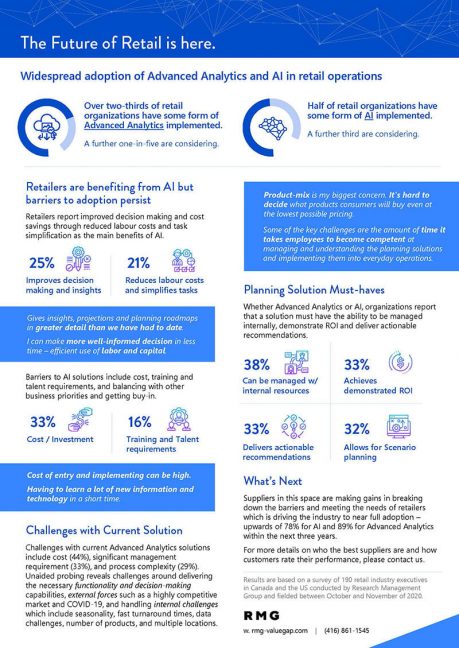Sponsored content
Whether AI or advanced analytics, North American merchant organizations are stepping up their investment in new technologies, which is driving the retail industry to near full adoption. According to a survey conducted by the Research Management Group (RMG) in 2020, approximately 78 percent of the industry will have adopted AI and 89 percent will have adopted advanced analytics within the next three years. 
Making changes to legacy planning systems that have been around, in most cases, since the last century is undoubtedly a challenging initiative. But to compete in the complex, competitive and changing retail environment today, adopting these technologies is no longer optional, rather it is essential for long-term survival.
What is the role of AI in the merchant function?
The role that AI fulfills in the merchant function is to optimize and make millions of decisions on items, price points, channel types and timing. The AI then precisely forecasts the impact of these decisions across an entire organization.
This is the work that analysts and data scientists have traditionally performed. However, AI performs these tasks much more effectively, eclipsing human ability. The merchant’s role subsequently becomes much more strategic, working to establish the direction and constraints within which the AI technology will operate to ensure that its decisions align with the wider goals and strategies of the business.
What does AI implementation achieve within an organization?
A full picture
AI provides retailers with a wide picture of what drives the merchant’s business, one which is not limited to a category-by-category view. In fact, according to the 2020 survey conducted by RMG pictured below, 25 percent of retail executives reported that AI enables better decision making and insights, which can be attributed to its ability to consider the entirety of a business. One executive noted: “[AI] Gives insights, projections and planning roadmaps in greater detail than we have had to date.”
Support building strategies
Within the aforementioned group of executives, 21 percent also reported a reduction in labour costs and more simplified tasks, which came as a direct result of AI implementation. The advanced AI tools coming to market take on the difficult to do manual tasks, enabling merchants to focus on more strategic endeavours and tasks that will maximize enterprise value. As one executive pointed out, AI results in a more “efficient use of labour and capital.”
Improved sales
Thirty-three percent of the organizations surveyed by RMG reported that a solution must have a demonstrable ROI. Not only does AI enable improved sales, which comes with optimizing item and price across the whole store, but AI comes with greatly improved efficiencies and reduced cost throughout the entire supply chain. The end result is a demonstratable ROI and ultimately a better experience for the customer, whose loyalty is gained and retained.

Barriers that affect AI and advanced analytics implementation
Though retailers are undoubtedly benefitting from AI and advanced analytics technologies, there still remain barriers to successful implementation. According to RMG, 44 percent of organizations report that a main challenge with the current solutions include cost, while 33 percent report significant management requirement as a barrier and 29 percent are limited by process complexity.
A deeper look into the challenges of technology adoption reveals that delivering the necessary functionality and decision-making capabilities also remains a significant barrier. Furthermore, external forces, such as a highly competitive market and COVID-19, combined with various internal challenges, including seasonality, data challenges, etc., also make it difficult to successfully implement these technologies.
However, though barriers undeniably exist for most retailers, AI implementation doesn’t have to be a pipe dream. A staged approach, with a focus on explainability, transparency and clarity, and proof of value, makes AI both easier to accept and trust and easier to implement logistically across an organization.
Conclusion
The data doesn’t lie. The adoption of new technologies has resulted in a transformation of the retail industry. What’s more, the implementation of these technologies is undeniably improving retail organizations, making them more efficient and profitable.
Though implementation can be both daunting and challenging, it continues to remain necessary, not optional, to keep pace in the current environment.
Learn how to action the Halo Effect using automation to maximize potential and grow profits without raising prices, download our whitepaper here.

